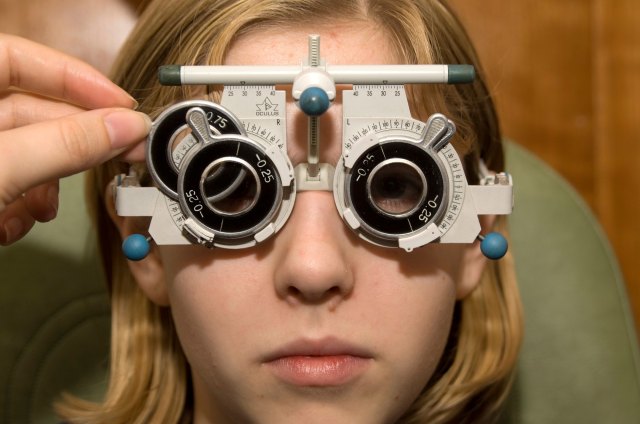Are kids spending too much time indoors? Credit: Photofusion/Universal Images Group via Getty Images

K-pop is short for Korean pop music. It’s a global phenomenon – with Korean boybands and girlbands breaking through into the music markets of neighbouring countries and, more recently, the West.
But there’s something odd about the perfectly choreographed, meticulously turned-out K-pop idols adorning bedroom wall posters across the planet – none of them are wearing glasses. Well not odd, because in showbiz image is everything – but, rather, at odds with the astonishingly high levels of shortsightedness among young Koreans.
Back in 2015, Nature published an article on the phenomenon by Elie Dolgin – and, if you’ll forgive me, it’s a proper eye-opener. It seems that the world is in the grip of a myopia epidemic – with an especially high rate of incidence in East Asia:
“East Asia has been gripped by an unprecedented rise in myopia, also known as short-sightedness. Sixty years ago, 10–20% of the Chinese population was short-sighted. Today, up to 90% of teenagers and young adults are. In Seoul, a whopping 96.5% of 19-year-old men are short-sighted.”
It’s been getting worse elsewhere too:
“Other parts of the world have also seen a dramatic increase in the condition, which now affects around half of young adults in the United States and Europe — double the prevalence of half a century ago.”
What on Earth is going on? Variations between different populations might suggest a genetic component, but Dolgin, noting the astonishing rise in cases from one generation to the next, says that “genetic changes happen too slowly to explain this rapid change”.
We might be tempted to shrug our shoulders – after all, it’s a pretty minor condition, isn’t it? Well, not for everyone:
“In severe cases, the deformation [of the eyeball] stretches and thins the inner parts of the eye, which increases the risk of retinal detachment, cataracts, glaucoma and even blindness… about one-fifth of university-aged people in East Asia now have this extreme form of myopia, and half of them are expected to develop irreversible vision loss.”
A recent article in Optometry Times, by Raman P Sah, confirms the threat:
“Myopia is now one of the leading causes of vision impairment and blindness in the world… The increasing prevalence of myopia has emerged as a global health concern because of sight-threating pathologies like myopic macular degeneration, choroidal neovascularization, cataract, and glaucoma associated with high myopia.”
When a potentially serious medical condition that used to be rare (at least among young people) becomes increasingly common, we need to know what’s causing it.
Can we blame reading for the epidemic – whether it’s printed material or, more latterly, electronic media? Is all that squinting over page and screen harming our eyesight? Dolgin argues that it isn’t – at least not directly.
Researchers believe that the real problem is not with the act of reading (or checking social media apps or playing computer games), but with where such activity normally takes place: indoors. Dolgin guides us through the compelling evidence that exposure to the brightness of daylight helps young eyes stay healthy.
Of course, humans have been spending time indoors ever since our ancestors built the first hut. But in recent times we’ve conspired to keep ourselves – and especially our children – cooped-up as never before.
Though we fret about the impact of modern life (and especially new technology) on our wellbeing, we’re rather selective in our concerns. We pay a lot of attention to some potential threats (e.g. smartphone addiction) and surprisingly little to others (see above).
Yes, it’s true that social media exposes young people to pressures and influences that previous generations did not experience, but what about all the other ways in which we’ve altered the physical and social environment in which children grow up? I’d say that any factor that prevents children getting enough sunshine is worth worrying about.
Back in the 1990s, I got chatting to a very nice bunch of Seventh Day Adventists. They were missionaries, of a kind – dedicated to a Biblically-based programme of health and well-being. They summed up their approach in the acronym NEW START, which stands for Nutrition, Exercise, Water, Sunshine, Temperance, fresh Air, Rest, and Trust in God.
Decades on, it strikes me that contemporary culture is now very keen on the NEW part of that formula (even if the ‘water’ bit is now called ‘hydration’). However, we’re not so good when in comes to the START. Obviously, Trust in God is a challenge to our sadly untrusting secular society, but we could make more of an effort on the STAR. Making sure children get the sleep they need, and stay away from the alcohol and other substances they definitely don’t need, is a matter of control (and teaching self-control), but to give them more sunshine and fresh air, we need to set them loose.
It’s time to return to a free-range childhood with plenty of unstructured, unsupervised outdoor play. Of course, that requires reasonably clean and safe places for them to play in, but adults (including parents, teachers and the various regulators of the public realm) also need to get over their paranoid, risk-averse mind-set.
In over-protecting children and over-organising their lives, we may be doing them real physical harm.
If we really care about our kids, we should kick ’em out.










Join the discussion
Join like minded readers that support our journalism by becoming a paid subscriber
To join the discussion in the comments, become a paid subscriber.
Join like minded readers that support our journalism, read unlimited articles and enjoy other subscriber-only benefits.
Subscribe